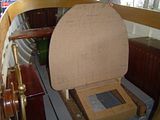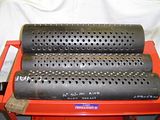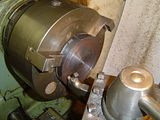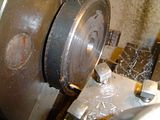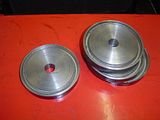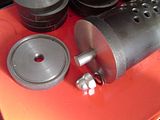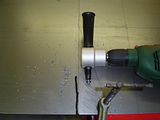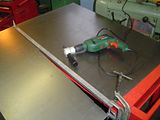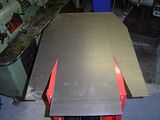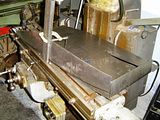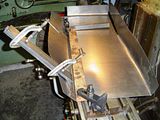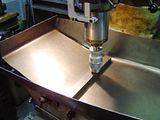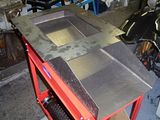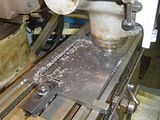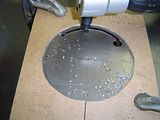I used my milling machine to drill the holes. The table travel is long enough to do a whole row of holes at one clamp setting. The drum was clamped down on to two wooden V blocks, with wood packing sawn to the inside radius at each end. I carefully checked the longitudinal setting then used the table measurement to centre drill and pilot drill at the required 25mm centres.

After I had done the first row and was in the course of rotating the drum to the next row, I realised that I had not checked properly that the holes were properly radial to the drum centre – in other words the line of holes was in the 12 o’clock position. To do this, I made a template on a piece of MDF. It has a batten at the edge and a perpendicular line at an offset of half the drum outside diameter. So when the batten is held against the outside of the drum the line of holes can be set up correctly.

I took it easy with the drilling. Each hole has 5 operations - centre drill to locate and start the hole; a 6mm drill to penetrate right through; an 11mm drill to take out most of the metal, my new 11.75m drill and finally the 12mm hand reamer, used in the chuck and run slowly. The steam drum has 180 holes - sometimes I had to remind myself I was enjoying this. Still have the same number to do in the mud drums!

I started thinking about the casing and ashpan. My idea is to slide the drums into the basic casing shell and then insert the tubes - a different approach from Roger who has built the pressure vessel first before starting the casing. So I need the two end panels welded to a base plate, and the top panel to keep it apart. I don’t have sheet metal working or welding facilities so will need to contract out these parts of the build. The drawings give casing and mounting details, but inevitably I am varying these to suit my boat so can’t give the drawing straight to a fabricator.
My approach was to mock up the components full size on to thin MDF, and mark on the dimensions. While I was in the groove with this I did the ashpan too, and stitched it all together with wire at the corners.



Before giving this over to a fabricator, I need to find the inside size of the 6” stainless flue pipe specified for the inner funnel, to give the diameter of a spigot to be welded to the top panel for the funnel to be a good sliding fit over. So I’ve ordered this pipe (ebay).
John


